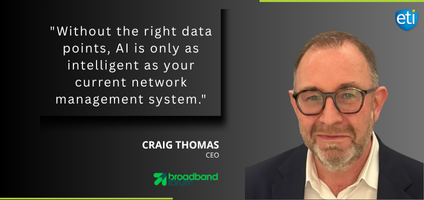
The following summary has been condensed for length and readability. To listen to the full discussion, click here. This episode is sponsored by intelegrate and VETRO FiberMap.
In this Broadband Bunch episode, recorded live at Fiber Connect 2025, host Pete Pizzutillo speaks with Craig Thomas, CEO of the Broadband Forum. The conversation explores how broadband standards, interoperability, and data-driven innovation are shaping the industry—especially for smaller operators navigating rapid technological change.
Craig begins by outlining the Broadband Forum’s mission: to create standards, drive interoperability, and ensure multi-vendor solutions are proven for service providers. Beyond developing standards and architectures, the Forum runs certification programs, develops open-source software, and leads technical workshops like those hosted in partnership with the Fiber Broadband Association at Fiber Connect.
While tier 1 operators often have the resources to influence and implement standards, Craig emphasizes that the need for interoperability is even greater for tier 2, 3, and 4 providers. As consolidation continues in the market, having vendor systems work seamlessly together is crucial—whether integrating within a single network or merging with another.
The conversation shifts to data’s role in enabling AI. Craig points out that without accurate, accessible data, AI cannot deliver meaningful insights or automation. Whether for personalized services, network planning, or operational efficiency, data is the foundation. Smaller operators, Craig notes, must define what AI means for their business—whether that’s generative AI, analytical AI, or network planning AI—and align it with their goals.
One of the biggest challenges to AI adoption and operational efficiency is data silos. Even within organizations, teams can be reluctant to share information. Craig stresses that network planning AI requires end-to-end visibility—from subscriber devices to the network core—and often benefits from anonymous data sharing across operators. Legal and regulatory concerns remain a hurdle, and Craig advocates for bringing technical and legal teams together to define safe, mutually beneficial data-sharing models.
The discussion moves to open-access networks, where multiple ISPs operate over a shared infrastructure. Craig highlights three key challenges:
Security – Ensuring every peering point is secure in an environment with multiple operators.
Visibility – Eliminating “finger pointing” between providers by giving each clear performance metrics.
Differentiation – Enabling ISPs to compete on more than price or customer service, through capabilities like network slicing via Fixed Access Network Sharing (FANs).
Pete and Craig also examine the blurring lines between OSS and BSS systems. As more functions converge and orchestration layers emerge, barriers between operational and business systems are breaking down. Craig sees orchestration—both at the network and service level—as a critical step toward eliminating silos and enabling agility.
Craig’s advice for operators is clear:
Define your AI goals and understand the specific type of AI that aligns with your needs.
Invest in data quality and accessibility to unlock automation and personalization.
Embrace standards and interoperability to future-proof your network and enhance enterprise value.
The episode wraps with Craig inviting service providers to get involved with the Broadband Forum, contribute to standards development, and join upcoming events—including their next member meeting in Munich.
© 2025 Enhanced Telecommunications.